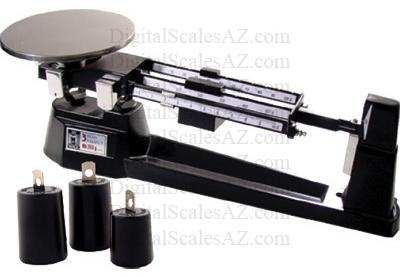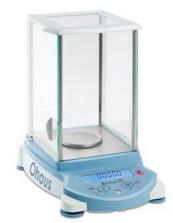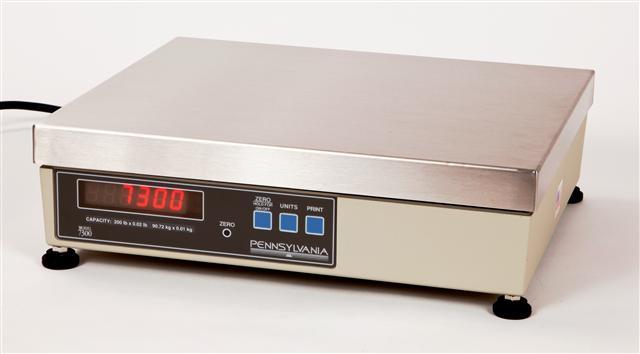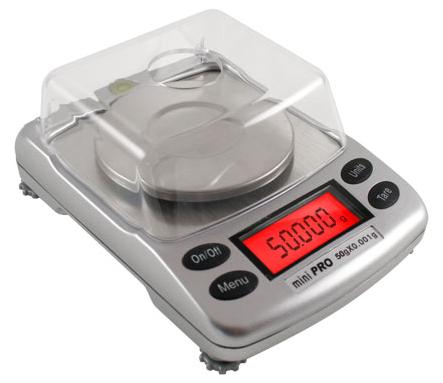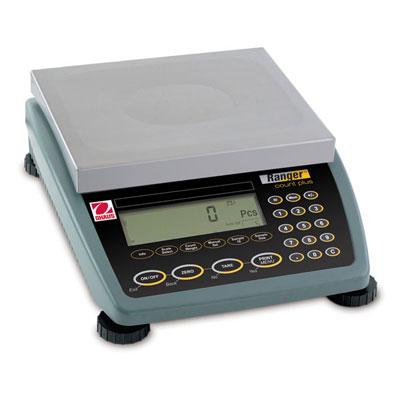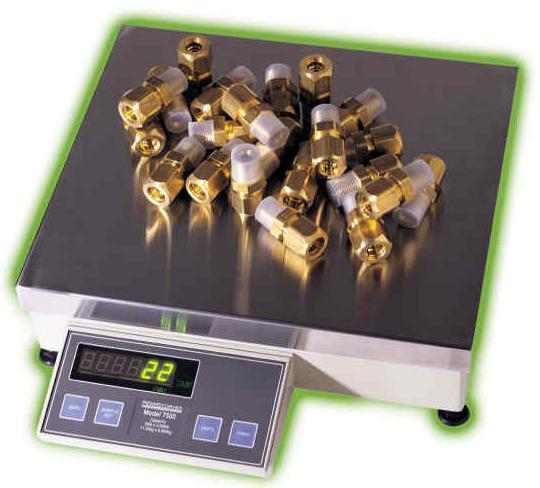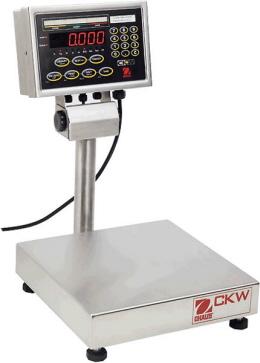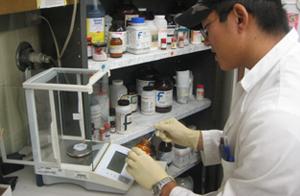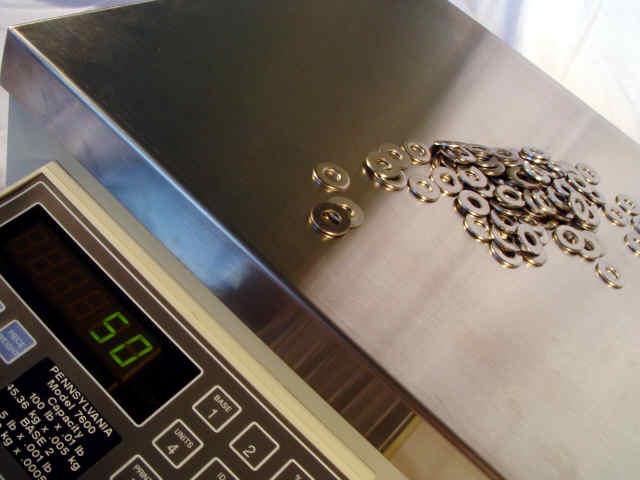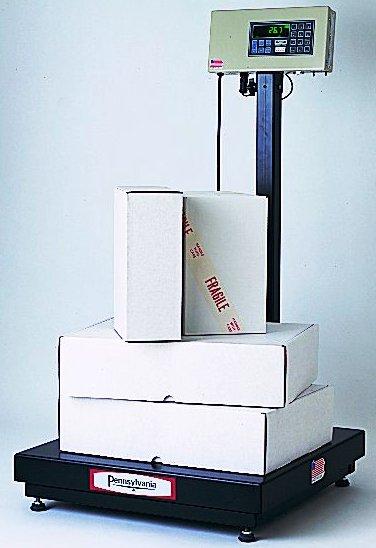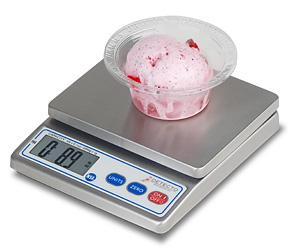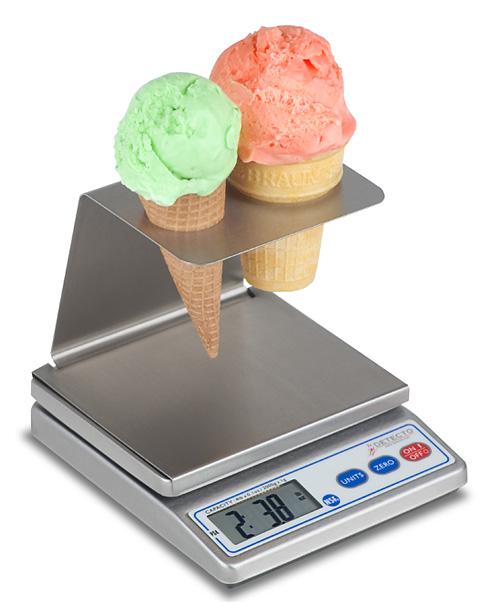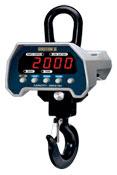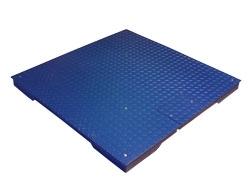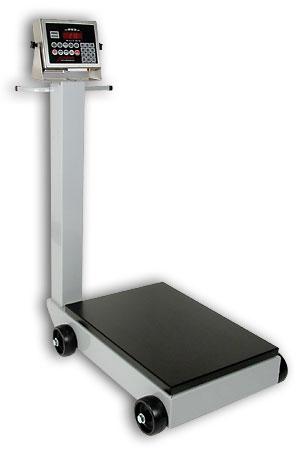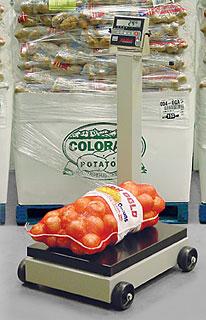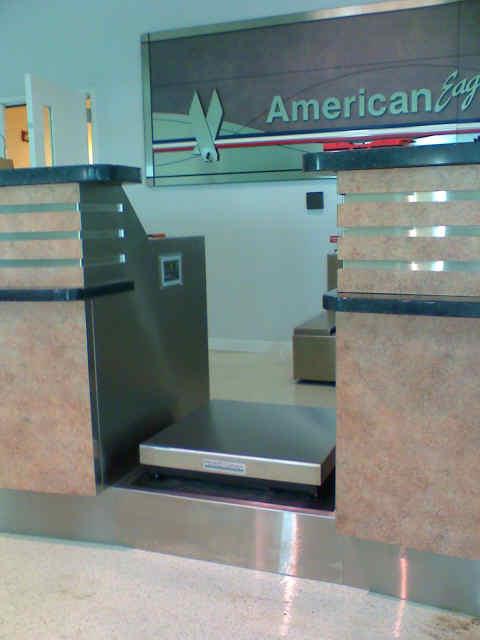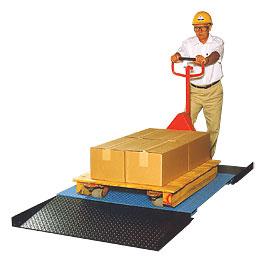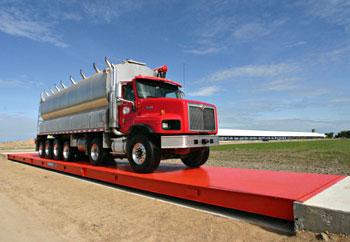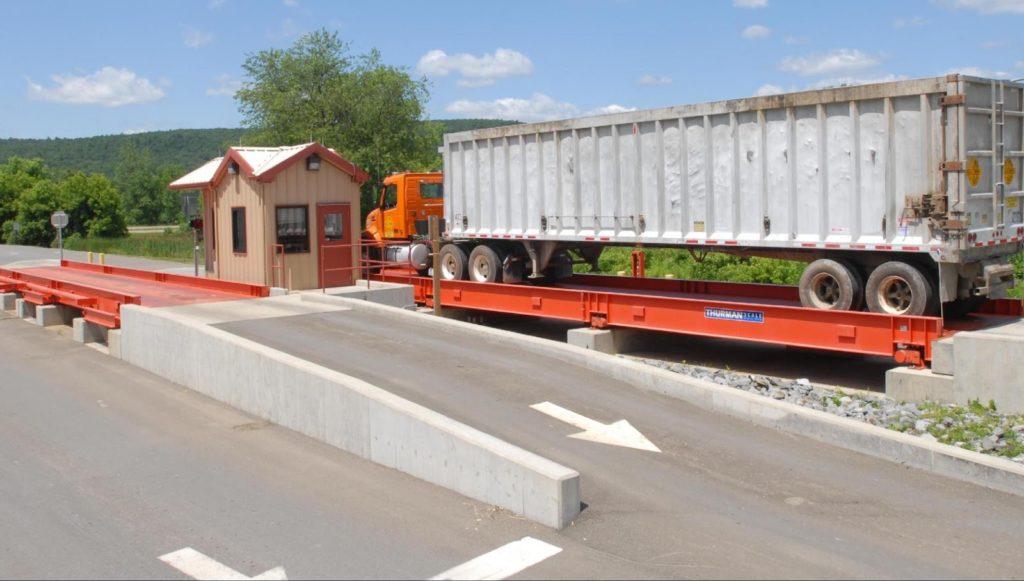Scales are used to weigh materials and equipment. The type of scale selected is based on the measuring needs. Each of the types of scales below contains information on general information, equipment design, usage examples, and advantages/disadvantages.
Beam
General Information/Equipment Design
Beam scales, or beam balances as they are more commonly known, are manual types of scales.
The balance is first tared by adjusting the knob on the left when the tray is empty. The items being weighed are placed on the platform. The weight is moved along each beam until the arrows match. The beams are divided into one hundred-gram, ten-gram, or one-gram divisions for metric scales. The larger weights are balanced first. Then the fine-tuning takes place on the smaller weight beams. For increased accuracy, a dial is sometimes used to move the lever along the lowest weight beam
(Copyright Digital Scales AZ, Tempe, AZ)
Usage Examples
Beam balances are typically used in laboratory settings. Different platforms can be used to weigh solids, liquids, or powders. The balances above are used in laboratory settings.
Advantages
- Easy to use.
- No internal moving parts to repair.
- Compact.
- Inexpensive.
Disadvantages
- Less accurate than electric scales.
- Cannot weigh very heavy objects.
Tabletop
Tabletop scales are the smallest type of electric scale. They can be used to check the weight of an object within a specific range, count the number of objects on the platform, or simply find the weight of the object.
General Information
Tabletop scales are used in applications when objects in the range of a few milligrams to around 250 kg need to be weighed. These scales can be laboratory, counting, checkweigh, or bench models, as shown here.
Equipment Design
Laboratory
Laboratory scales, also known as portable scales, are small digital weighing devices. They are usually of fairly simple design with a platform, a display, and one or two command buttons.
Some laboratory scales, such as in the left picture are outfitted with a cover. The cover allows for more precise measurements by keeping out air and particles. Doors on either side and at the top of the cover give the user access to the platform.
(Copyright Digital Scales AZ, Tempe, AZ)
Count
Counting scales are useful because they allow the user to count the number of objects placed on the platform as well as find the total weight of a sample. These scales can be combined with bench or floor scales for speed and accuracy in weighing heavier objects. Counting scales can also have more than one platform for finer measurements.
Checkweigh
Checkweighers allow users to enter a specified weight and the scale will report whether the object on the platform is under, over, or the same as the designated amount.
Checkweighers are similar in design to bench scales; they differ only in function. In a checkweigh scale the platform can be directly attached to the digital indicator, or it can be connected to a wall-mounted indicator by a wire.
Bench
Bench scales are designed to be set on top of a laboratory bench. They can be used to weigh light-to-medium-capacity, 2.5-500 kg, objects. Stainless steel is usually used to construct these scales because of its durability and resistance to rust. A load cell is used as a weight inside the scale. An indicator must be attached to the scale to display the weight of the object.
Usage Examples
Laboratory scales are used in biological and chemical industries. They are convenient for their small size and their ease of use. The picture shown here is an example of a scale used in a laboratory.
Counting scales are used in a variety of industries. They are useful in weighing solids of a given size. Warehouses use counting scales for inventory and packaging applications. The picture below shows a scale being used to count washers.
Checkweighers are used when a specified weight is desired. Examples of uses for these scales are packaging and food preparation.
The scale seen here is measuring packages to determine if they are within the desired weight range.
Bench scales are primarily used in the chemical and food processing industries. They are also used in many commercial applications. One such application is in grocery stores and delicatessens to weigh meats and produce. Bench scales are also used for portion control like the scales below measuring ice cream portions.
(Copyright Cardinal Scale Manufacturing Co., Webb City, MO)
Advantages
- Compact and portable.
- Optional cover increases accuracy in measurement with laboratory scales.
- Counting scales allow users to count number of objects as well as find total weight.
- Counting scales also can be easily integrated with other scales to increase speed and accuracy.
- With checkweigh scales, user usually has the option of checkweighing or finding the actual weight.
- Useful when looking for a target weight.
- Bench scales easy to clean so ideal for sanitized areas.
Disadvantages
- Can not weigh heavy objects in large quantities.
- Less accurate than some larger scales.
- Can not weigh very heavy objects with high accuracy.
Crane
General Information/Equipment Design
Crane scales are designed to weigh objects that hang from them. A hook attached to the bottom of the device indicates the weight of the object on the digital indicator. Aluminum and stainless steel are the two most common materials in the construction of these scales.
Crane scales such as the one shown here can be designed to weigh objects anywhere from 5 to 500,000 lb. This versatility makes them ideal in many applications.
Usage Examples
Crane scales are used in many industries. Mainly they are used in steel mills, shipyards, and warehouses because of their diverse range of weights. Smaller crane scales, or hanging scales, are often used in grocery stores to weigh produce. The scale shown below is an example of this.
Advantages
- Diverse range of weights.
- Ideal for objects that are moved by cranes.
Disadvantages
- Can not weigh objects without a loop or chain attached to the top.
Floor
Floor scales are designed to weigh heavier objects that can be placed or rolled on top of the platform.
General Information
Scales that are placed on the floor come in two categories: platform and floor. The major difference between these two styles is the amount of weight each can handle. Also, platform scales are typically portable while floor scales are stationary. Both types are designed to handle much more weight than any of the tabletop scales. The platform scale below can hold up to 2,500 lbs.
Equipment Design
Platform
Platform scales are called so because the object being weighed is placed on a platform. They can weigh objects between 500 and 1000 pounds. A ramp is typically needed to move the object onto the apparatus. Platform scales are usually portable since they weigh much less, and are much easier to move, than the objects that they are designed to weigh. The scale shown to the left comes equipped with handles to allow for easier mobility. Similarly, the portable scale on the right has wheels.
Floor
Floor scales are similar to platform scales, but they are able to weigh much larger objects. The range for floor scales is between 1000 and 30000 pounds. Load cells inside of the scale signal the weight of the object to the attached indicator. The scale below can hold up to 3000 lbs and is precise to 1 lb.
Usage Examples
Quite often platform scales are used to weigh larger objects such as drums or pails like those seen below. They can also weigh containers filled with hazardous materials.
Platform scales are also commonly used in the agricultural industry to weigh large animals. Additionally, platform scales can be used to weigh produce as in the picture shown below. The platform scale to the right is used to weigh elephants at the Atlanta Zoo.
Platform scales are also used in airports at check in stations to weigh baggage, as shown below.
Floor scales are used for heavy, bulky objects. Some floor scales have ramps so that the objects and be placed on the platform using a dolly or pallet jack.
This floor scale is being used to weigh a pallet before it is shipped.
Advantages
- Used to weigh larger and heavier objects.
- Usually have a ramp for easy loading and unloading of object being weighed.
Disadvantages
- Floor scales are not always portable and therefore take up floor space.
Truck
General Information/Equipment Design
Truck scales are heavy-duty scales designed to weigh large vehicles. Thick concrete reinforced by massive structural I-beams is necessary to withstand the weight of the objects on top. The structure of the foundation under the scale is determined by the ground composition and the regional climate.
Usage Examples
Truck scales are used in highway weigh stations, grain elevators, cement plants, stone quarries, and mines. They are necessary for heavy duty applications.
The truck seen here is on a scale outside of a highway weigh station.
Advantages
- Heavy-duty, durable.
- Usually have a long life span.
- Useful in specific applications.
Disadvantages
- Difficult to move.
- Deflection, or bending of the scale top, is common.
Acknowledgements
- Alliance Scale, Inc., Canton, MA
- Cardinal Scale Manufacturing Co., Webb City, MO
- Digital Scales AZ , Tempe, AZ
- Ohaus Corporation, Parsippany, NJ
- Pennsylvania Scale Company, Lancaster, PA
- Thurman Scales, Groveport, OH
Developers
- Katie Clise
- Keith Minbiole


